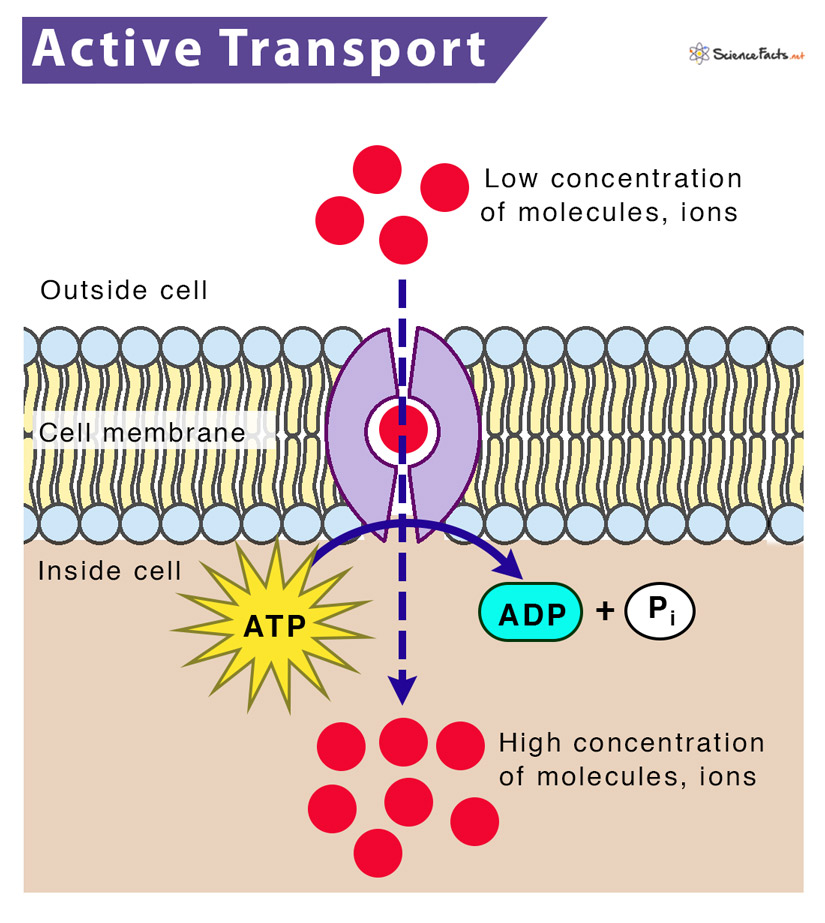Active Transport
What is Active Transport
Active transport is an energy or ATP-dependent, cellular transport process that selectively moves substances from an area of low concentration to an area of high concentration or ‘against the concentration gradient’, with the help of a membrane protein.
Characteristics of Active Transport
- Substances are transported against their concentration gradient
- It is a fast process
- Requires cellular energy
- Needs a helper transmembrane protein structure called ‘pumps’ for transport
Types of Active Transport with Examples
1) Primary Active Transport
A primary active transport process is one in which metabolic energy obtained from the breakdown of high-energy phosphate molecules – adenosine triphosphate (ATP), is used to transport solutes across the cell membrane. It is also called direct active transport or uniport.
What it Transports: Charged ions such as Na+, K+, Mg2+, and Ca2+.
Example: Sodium-potassium pump, which helps to move potassium into the cell and carry sodium out.
2) Secondary Active Transport
Also called coupled transport or cotransport, it involves the movement of substances across the cell membrane utilizing energy in other forms than ATP. This energy comes from the electrochemical gradient created by pumping ions out of the cell, which powers the movement of another ion or molecule in the same direction (symport) or opposite direction (antiport) of the membrane.
What it Transports: Na+, K+, adenosine triphosphate (ATP), adenosine diphosphate (ADP), and inorganic phosphate (Pi).
Example: Cotransporting glucose and sodium in the small intestine using sodium-glucose transporter.
Functions of Active Transport in Cells
In Plants
- Essential for the absorption of water and minerals from the soil by the root hair cells
In Animals
- Necessary for the secretion of metabolic products such as ions, digestive enzymes, and hormones, and the elimination of toxic wastes from cells, by a form of active transport, called exocytosis
- Helps in the absorption of nutrients by cells, engulfing pathogens by white blood cells, and swallowing food by bacteria occurs by a process called endocytosis, another form of active transport
- Helps in signal transduction that prepares the cell to adapt to its changing environment
FAQs
Ans. Active transport needs energy either directly as ATP or that generated from the electrochemical gradient to transport substances from their low to a high concentration across the cell membrane.
Ans.The main difference is that in primary active transport, the energy to carry out the process is derived directly from the breakdown of ATP, while in secondary active transport, the energy is derived from the difference in concentration of ions between the two sides of a membrane.
Ans.The similarity is that both use helper transmembrane proteins to transport ions, sugars, and salts in and out of the cell.
Ans.The main difference is that facilitated diffusion does not require energy to carry out the process, whereas active transport uses either metabolic or electrochemical energy to perform the process.
Ans.The membrane structures that function in active transport are proteins and lipids.
Ans. Diffusion is a physical or biological process involving the spontaneous movement of substances from their high concentration to low concentration without the need for energy. In contrast, active transport is an energy-dependent biological process that involves the movement of substances from an area of low concentration to an area of high concentration across the cell membrane.
Ans. Osmosis is the movement of solvent molecules from an area of high solute concentration to an area of low solute concentration across a selectively permeable membrane. In contrast, active transport is the movement of solute from an area of their low concentration to an area of high concentration across a selectively permeable membrane.
Ans. Mitochondria is the cell organelle that produces the energy required for active transport.
Ans. Active transport moves essential ions and molecules from their low to the high concentration and thus helps to maintain their right balance inside the cell.
-
References
Article was last reviewed on Thursday, February 2, 2023




